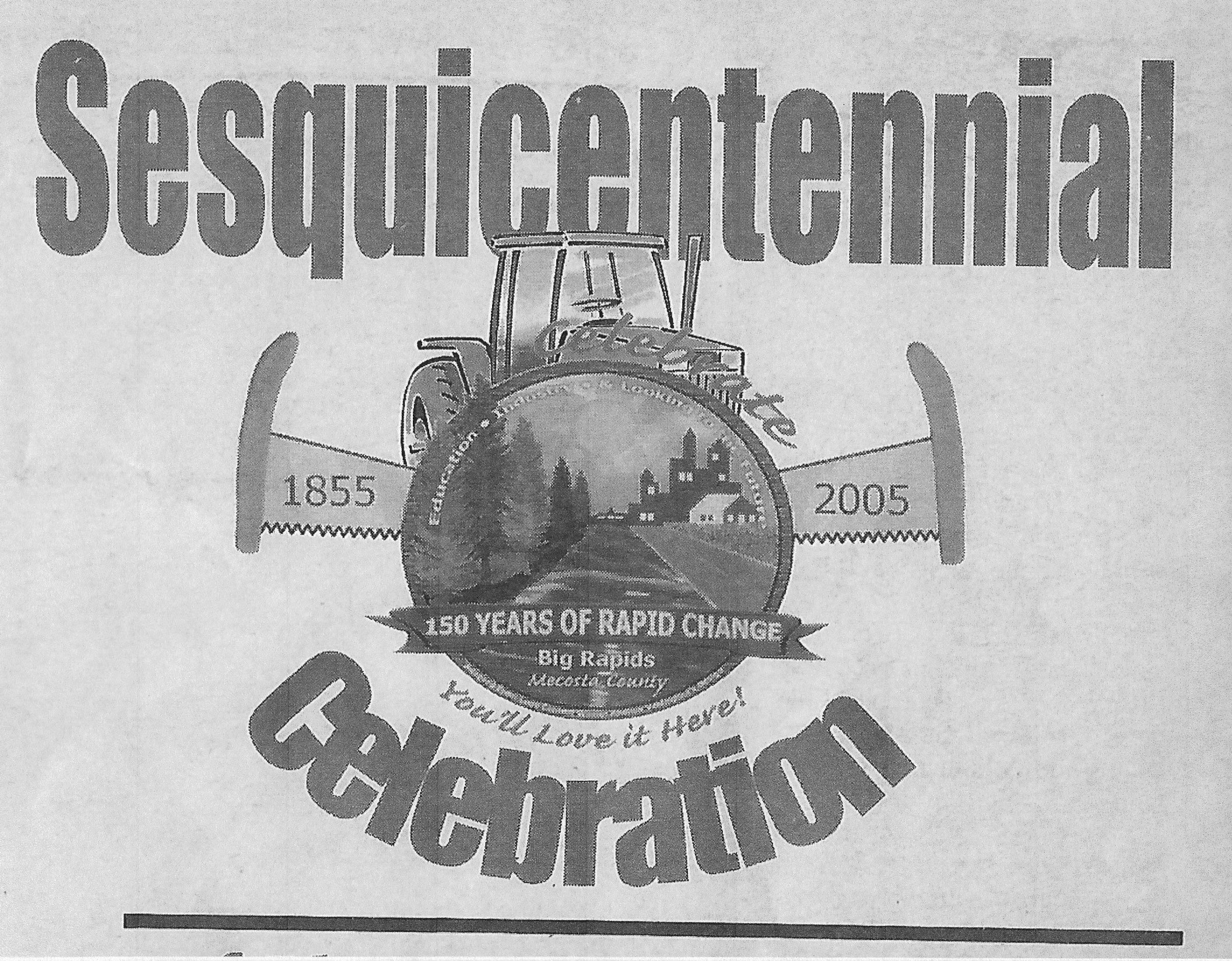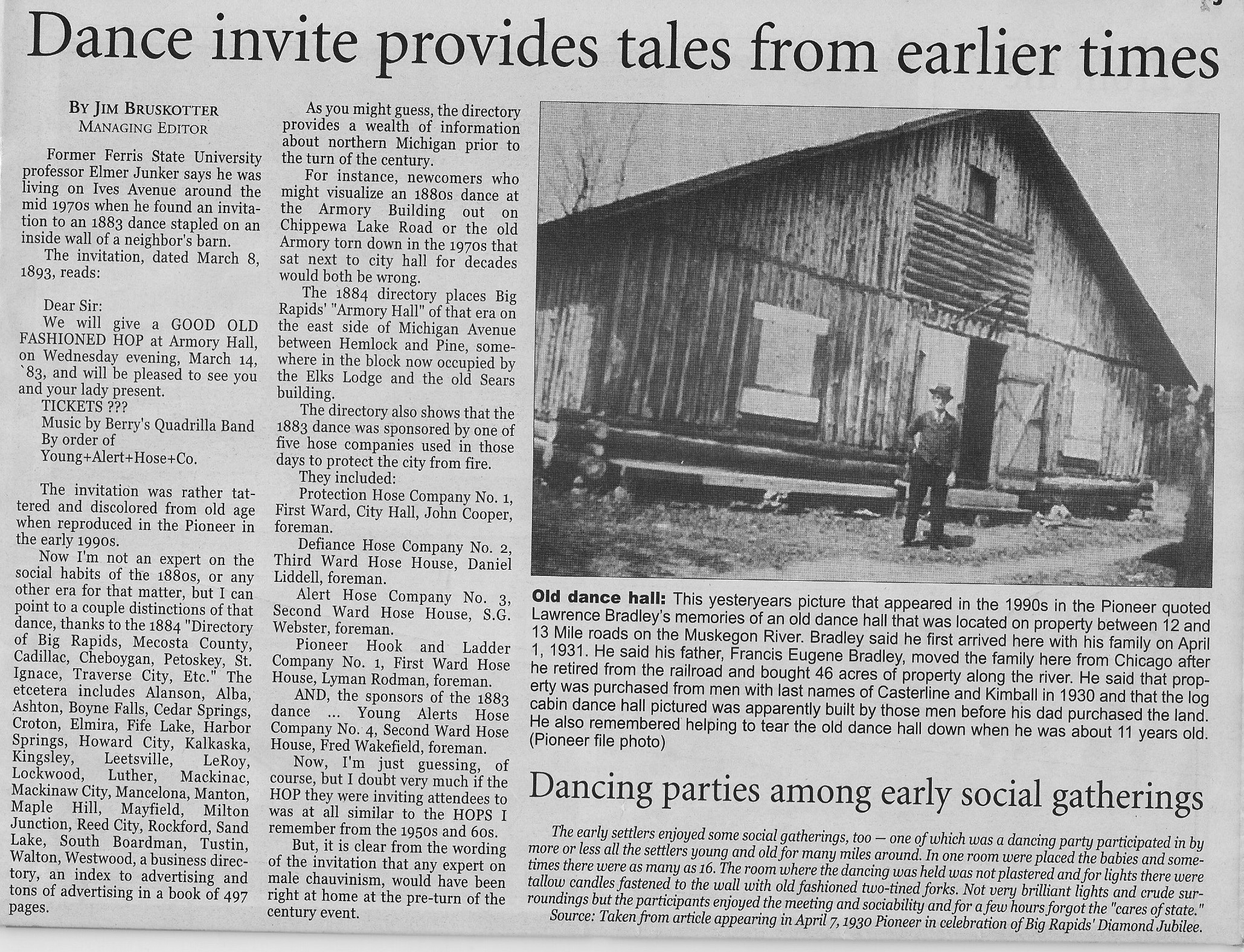
Part III - Culture, a supplement to the Big Rapids Pioneer Newspaper. Used with permission.

Old dance Hall: This yesteryears picture that appeared in the 1990's in the Pioneer quoted Lawrence Bradley's memories of an old dance hall that was located on property between 12 and 13 Mile Roads on the Muskegon River. Bradley said he first arrived here with his family on April 1, 1931. He said his father, Francis Eugene Bradley, moved the family here from Chicago after he retired from the raillroad and bought 46 acres of property along the river. He said that property was puchased from men with last names of Casterline and Kimball in 1930 and that the log cabin dance hall pictured was apparently built by those men before his Dad purchased the land. He also remembered helping to tear the old dance hall down when he was about 11 years old. (Pioneer file photos)
DANCE INVITE PROVIDES TALES FROM EARLIER TIMES
By Jim Bruskotter, Managing Editor
Former Ferris State University professor Elmer Junker says he was living on Ives Avenue around the mid 1970's when he found an invitation to an 1883 dance stapled on an inside wall of a neighbor's barn.
The invitation dated March 8, 1893 reads:
Dear Sir:
Will give a GOOD OLD FASHIONED HOP at Armory Hall, on Wednesday evening, March 14, '83, and will be pleased to see you and your lady present.
TICKETS ???
Music by Berry's Quadrilla Band
By order of:
Young+Alert+Hose+Co.
The invitation was rather tatttered and discolored from old age when reproduced in the Pioneer in the early 1990's.
Now I'm not an expert on the social habits of the 1880's, or any other era for that matter, but I can point to a couple distinctions of that dance, thanks to the 1884 "Directory of Big Rapids, Mecosta County, Cadillac, Cheboygan, Petoskey, St. Ignace, Traverse City, etc.." The etcetera includes, Alanson, Alba, Ashton, Boyne Falls, Cedar Springs, Croton, Elmira, Fife Lake, Harbor Springs, Howard City, Kalkaska, Kingsley, Leetsville, Leroy, Lockwood, Luther, Mackinac, Mackinac City, Mancelona, Manton, Maple Hill, Mayfield, Milton Junction, Reed City, Rockwood, Sand Lake, South Boardman, Tustin, Walton, Westwood, a business directory, an index to advertising and tons of advertising in a book of 497 pages.
As you might guess, the directory provides a wealth of information about Northern Michigan prior to the turn of the century.
For instance, newcomers who might visualize an 1880's dance at the Armory Building out on Chippewa Lake Road or the old Armory torn down in the 1970's that sat next to the city hall for decades would both be wrong.
The 1884 directory places Big Rapods' Armory Hall of that era on the east side of Michigan Avenue between Hemlock and Pine; some-where in the block now occupied by the Elks Lodge and the old Sears building.
The directory also shows that the 1883 dance was sponsored by one of five hose companies used in those days to protect the city from fire.
They included:
Protection Hose Company No. 1, First Ward Hose House, John Cooper, foreman
Defiance Hose Company No. 2, Third Ware Hose House, Daniel Liddell, foreman.
Alert Hose Company No. 3, Second Ward Hose House, S.G. Webster, foreman
Pioneer Hook and Ladder Company No. 1, First Ward Hose House, Lyman Rodman, foreman
AND, the sponsors of the 1883 dance ... Young Alerts Hose Company No. 4, Second Ward, Hose House, Fred Wakefield, foreman
Now, I am just guessing, of course, but I doubt very much if the HOP they were inviting atendees to was at all similar to the HOPS I remember fro the 1950's and 60's.
But, it is clear from the wording of the invitation that an expert on male chauvinism, would have been right at home at the pre-turn of the century event.
DANCING PARTIES AMONG EARLY SOCIAL GATHERINGS
The early settlers enjoyed some social gatherings, too - one of which was a dancing party participated in by more or less all the settlers young and old for many miles around. In one room were placed the babies and some times there were as many as 16. The room where the dancing was held was not plastered and for lights there were tallow candles fastened to the wall wilth old fashioned two-tined forks. Not very brilliant light and crude surroundings but the participants enjoyed the meeting and sociability and for a few hours forgot the "cares of state." Source: Taken from article appearing in April 7, 1930 Pioneer in celebration of Big Rapids' Diamond Jubilee.
Return to Mecosta sesquicentennial Page
Return to Home Page


